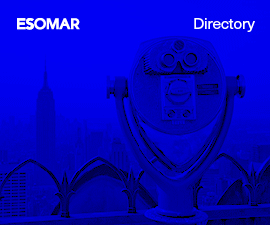- What we do
- Membership
- Knowledge
- Events
- Contact
Log in to your MyESOMAR account

You searched for: "" but we corrected it to "*"
Did you mean to search for ""? Click here to show those results.
The results has been filter on Tags containing Peoplemeters.
ANA has found 45 results for you, in
188 ms.
Currently showing results 19 to 27.
Didn’t find what you were looking for? Try the Advanced Search!
Research papers
 The UK reach and frequency model
The UK reach and frequency model
The basis of a reach and frequency analysis is a count of the number of commercial spots seen by each individual in an advertising schedule. When this analysis is constructed from a people meter panel that reports on a daily basis, the obvious start...
Catalogue: ESOMAR/ARF Worldwide Broadcast Audience Research Symposium 1992
Author: Steve Wilcox
 June 15, 1992
June 15, 1992
Citation
Wilcox, S. (1992a, June 15). The UK reach and frequency model. ANA - ESOMAR. Retrieved April 28, 2024, from
https://ana.esomar.org/documents/the-uk-reach-and-frequency-model-4001
Research papers
 Diaries VS people meters
Diaries VS people meters
The paper is divided in two parts. The first part compares the data generated by diaries and people meters in Canada. The comparison shows that both ratings systems generate data that is very similar in terms of general viewing behaviour. For...
Catalogue: ESOMAR/ARF Worldwide Broadcast Audience Research Symposium 1992
Authors: Stan Staple, Chantal Mayrand
 June 15, 1992
June 15, 1992
Citation
Staple and Mayrand (1992a, June 15). Diaries VS people meters. ANA - ESOMAR. Retrieved April 28, 2024, from
https://ana.esomar.org/documents/diaries-vs-people-meters
Research papers
 An overview of the transition from diary-based television audience measurement to people meters in Australia and New Zealand, 1989-1991
An overview of the transition from diary-based television audience measurement to people meters in Australia and New Zealand, 1989-1991
This paper reconstructs the history of the introduction of People Meters to Australia and New Zealand during 1989-1991. The rival multinational People Meter operators invested heavily in the race to secure contracts to provide ratings services in the...
Catalogue: ESOMAR/ARF Worldwide Broadcast Audience Research Symposium 1992
Author: Terence W. Beed
 June 15, 1992
June 15, 1992
Citation
Beed, T. W. (1992a, June 15). An overview of the transition from diary-based television audience measurement to people meters in Australia and New Zealand, 1989-1991. ANA - ESOMAR. Retrieved April 28, 2024, from
Research papers
 How differences between techniques affect the advertiser in Europe
How differences between techniques affect the advertiser in Europe
The map of Europe is deceptively simple as far as TV measurement is concerned. The same technique (a panel equipped with electronic set and people meters) is used in every country, or will be by the end of the year, and only 2 companies, AGB and GFK,...
Catalogue: ESOMAR/ARF Worldwide Broadcast Audience Research Symposium 1992
Author: Jane Perry
 June 15, 1992
June 15, 1992
Citation
Perry, J. (1992a, June 15). How differences between techniques affect the advertiser in Europe. ANA - ESOMAR. Retrieved April 28, 2024, from
https://ana.esomar.org/documents/how-differences-between-techniques-affect-the-advertiser-in-europe
Research papers
 Problems of non-response and non-cooperation in a people meter panel
Problems of non-response and non-cooperation in a people meter panel
The quality of any audience measurement system is dependent on the quality of the sample upon which its data are based. This paper presents the results of two pieces of research that examine different aspects of A.C. Nielsen's network people meter...
Catalogue: ESOMAR/ARF Worldwide Broadcast Audience Research Symposium 1992
Authors: Barry Kiefl, David M. Tattle
Company: Nielsen
 June 15, 1992
June 15, 1992
Citation
Kiefl and Tattle (1992a, June 15). Problems of non-response and non-cooperation in a people meter panel. ANA - ESOMAR. Retrieved April 28, 2024, from
Research papers
 Local market television measurement: A comparison of the statistical reliability of three methodologies
Local market television measurement: A comparison of the statistical reliability of three methodologies
Since the introduction of the People Meters in the U.S., attention has been centered on its goodness as an accurate measurement method with particular emphasis on validation studies of audience levels. Relatively little attention has been focused on...
Catalogue: ESOMAR/ARF Worldwide Broadcast Audience Research Symposium 1992
Author: Michael Occhiogrosso
Company: Nielsen
 June 15, 1992
June 15, 1992
Citation
Occhiogrosso, M. (1992a, June 15). Local market television measurement: A comparison of the statistical reliability of three methodologies. ANA - ESOMAR. Retrieved April 28, 2024, from
Research papers
 Passive people meters and the ESOMAR codes of practice
Passive people meters and the ESOMAR codes of practice
The technology of PPMs is complex and still evolving. Although it seems likely that pilot experiments in the field will take place quite soon, the systems could still be changed before they become fully operational and/or alternative new systems may...
Catalogue: Seminar 1992: Media Research Meets The Future
Authors: John Downham, ESOMAR B.V.
 June 15, 1992
June 15, 1992
Citation
Downham and B.V. (1992a, June 15). Passive people meters and the ESOMAR codes of practice . ANA - ESOMAR. Retrieved April 28, 2024, from
https://ana.esomar.org/documents/passive-people-meters-and-the-esomar-codes-of-practice-
Research papers
 Experiments in the measurement of TV audience reactions
Experiments in the measurement of TV audience reactions
This paper deals with the measurement of program appreciation in the Netherlands. In the first part of this essay, attention is given to the value and applications of appreciation scores and the method of collecting them is discussed. Appreciation...
Catalogue: ESOMAR/ARF Worldwide Broadcast Audience Research Symposium 1992
Author: Wim Bekkers
 June 15, 1992
June 15, 1992
Citation
Bekkers, W. (1992a, June 15). Experiments in the measurement of TV audience reactions. ANA - ESOMAR. Retrieved April 28, 2024, from
https://ana.esomar.org/documents/experiments-in-the-measurement-of-tv-audience-reactions
Research papers
 What viewing are we measuring?
What viewing are we measuring?
A critical underpinning of the whole area of audience measurement is the definition that is used for â viewing. Although it is critical, it is also very difficult to get to grips with, because of the nature of the measurement process. Existing...
Catalogue: ESOMAR/ARF Worldwide Broadcast Audience Research Symposium 1992
Author: John Kaye
 June 15, 1992
June 15, 1992
Citation
Kaye, J. (1992a, June 15). What viewing are we measuring?. ANA - ESOMAR. Retrieved April 28, 2024, from
https://ana.esomar.org/documents/what-viewing-are-we-measuring-







